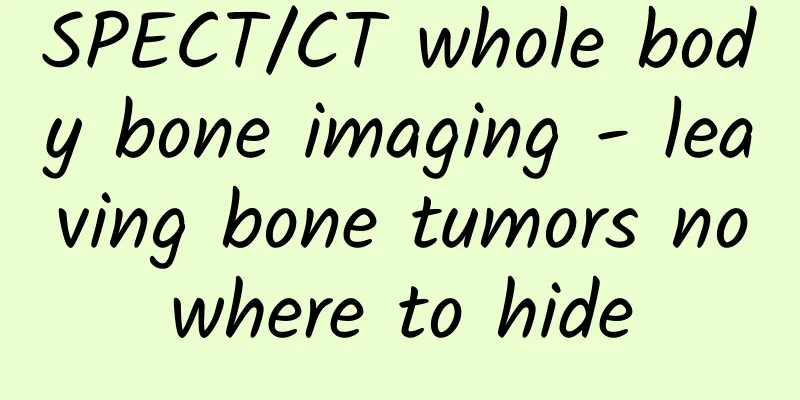SPECT/CT whole body bone imaging - leaving bone tumors nowhere to hide

|
What is SPECT/CT whole body bone imaging? Whole Body Bone Scan (WBBS), also known as bone scan, is a method of injecting radionuclide-labeled imaging agents (such as 99mTc-MDP) into the body, which are deposited in the bones through ion exchange, chemical adsorption, and combination with the organic components of the bones. The single-photon emission computed tomography (SPECT) scanner is used to obtain the distribution of the imaging agent after deposition in the bones throughout the body, thereby obtaining an image of the bones throughout the body. CT is a tomographic imaging technology that uses X-rays to penetrate the human body and obtain three-dimensional anatomical images through computer processing. SPECT/CT perfectly combines these two technologies, and can obtain detailed anatomical structure information and functional metabolic information in one examination, greatly improving the accuracy of diagnosis. The Nuclear Medicine Department installed a Siemens Symbia Intevo Blod SPECT/CT, which has high-definition bone-engraving technology and realizes the clinical diagnosis of qualitative and quantitative integration mode What are the advantages of SPECT/CT whole-body bone imaging in the diagnosis of bone tumors? Bone tumors are often accompanied by abnormal increases or decreases in the absorption of radioactivity by bones, which manifests as abnormal concentration or sparseness of radioactivity. SPECT/CT, with its high sensitivity and high resolution, can accurately detect these abnormalities and provide doctors with accurate diagnostic basis. For example, for tumors that are prone to bone metastasis, such as nasopharyngeal carcinoma, lung cancer, breast cancer, colorectal cancer, and prostate cancer, SPECT/CT can detect metastatic lesions early and help doctors formulate treatment plans as early as possible. At the same time, for patients with confirmed bone tumors, SPECT/CT can also be used for efficacy monitoring and prognosis judgment, by observing changes in radioactivity and the increase or decrease in the number of lesions, to evaluate treatment response and patient survival time. Whole body bone scintigraphy shows the whole body bone metastasis of tumor In addition, the whole-body bone imaging function of SPECT/CT enables it to understand the whole-body skeleton in one examination and find lesions beyond the scope of morphological examinations such as X-rays and CT. This comprehensive examination method undoubtedly provides more possibilities for the diagnosis of bone tumors. It is worth mentioning that the application of SPECT/CT in the diagnosis of bone tumors is not limited to early detection and location of lesions. It can also be used to evaluate the tumor's response to treatment and monitor the progression of the disease. This is of great significance for formulating and adjusting treatment plans and predicting the prognosis of patients. Finally, SPECT/CT whole-body bone imaging also has the advantages of being non-invasive, safe, and easy to operate. Patients do not need to endure additional pain and risks, and the examination process is relatively simple and quick, which provides great convenience for clinical diagnosis and treatment. In summary, SPECT/CT whole-body bone imaging has the advantages of high sensitivity, specificity, comprehensiveness, and safety in the diagnosis of bone tumors, and has become the preferred examination method for patients with malignant tumors to determine whether they have bone metastasis.
1. Before the examination, you need to drink plenty of water and urinate several times after the whole body bone imaging injection; if urine contaminates clothes and skin, you should scrub the skin and change clothes before the examination. Remove metal objects such as hairbands, earrings, necklaces and mobile phones before entering the examination room to avoid interference with the imaging effect. 2. Keep still during the examination and follow the staff's instructions and voice prompts. If you feel any discomfort, please inform the staff in time. 3. After the examination, wait in the observation room and leave only after the doctor notifies you. Avoid contact with pregnant women and infants on the day of the examination. Drink as much water or milk as possible to help the imaging agent be excreted from the body. In conclusion, whole-body bone imaging, as a nuclear medicine examination method, has a wide range of application value. It can detect bone tumors at an early stage, determine whether the tumor has metastasized, monitor the effect of treatment, determine the cause of fractures, determine bone marrow lesions, assist in the diagnosis of other bone diseases, and predict the risk of fractures. Whole-body bone imaging can provide an important reference for the diagnosis and treatment of patients. Author: Kong Weijian Reviewer: Zhao Yinlong |
>>: This kind of beans is perfect to eat in spring, but some people should eat it with caution
Recommend
Is it good for women to eat yam during menstruation?
I think many friends are not familiar with the na...
Girls have no period but have lower abdominal pain
We all know that when women have their periods, t...
What should I do if I feel abdominal discomfort during menstruation?
How many women have suffered from dysmenorrhea? O...
How can I get pregnant after removing the IUD?
Generally, women wear IUDs for contraception, but...
80% of people are not aware of the precautions for gynecological examinations
Gynecological diseases include many symptoms, whi...
Does Jackfruit smell bad? Why are there black spots on Jackfruit?
The flesh of jackfruit is yellow, but it tastes t...
How long after a chest X-ray can you get pregnant?
When patients have frequent coughs, they must car...
Is it good to wear sports bra for a long time?
Many women choose to wear sports bras when exerci...
One picture to understand: Yellow sputum, white sputum, bloody sputum? Identify sputum to know the disease!
The process of coughing up phlegm is the process ...
Do you know about cervical spondylosis?
This is the 3087th article of Da Yi Xiao Hu In pe...
How do you know if your cervix is detached?
After some gynecological surgeries, nursing work ...
What are the scenic spots and features on Huangshan Mountain? Why is the pine tree on the cliff the soul of Huangshan Mountain?
Huangshan is famous for its "five wonders&qu...
Why do the tips of the leaves of the peace tree always turn black? What should I do if the leaves of the peace tree turn black?
The peace tree is very common in life. Because of...
How long after the biopsy can I get the medication?
Cervical biopsy is a relatively common examinatio...
What to do if you have pancreatitis during pregnancy
If you suffer from pancreatitis during pregnancy,...









